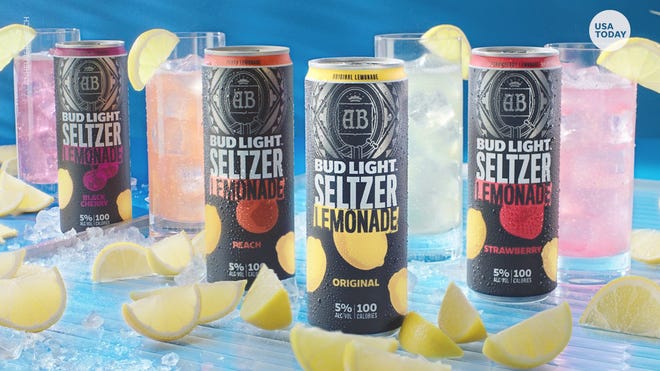
It was merely two years ago when hard seltzer giant White Claw's sales boomed so much panic began to set in among young adults seeking to get their hands on the trending drink as a shortage began throughout the United States.
Then in 2020, a perfect storm catapulted the buzzing drink from a hot trend to a multi-billion dollar industry almost immediately. Hard seltzer sales grew by 160% up to $4.1 billion in 2020, according to data from Nielsen. And by July 2021, more than 150 brands launched lines of hard seltzer across the U.S.
The growth was so profound that at the beginning of 2021, Goldman Sachs stated it expected the hard seltzer market to reach $30 billion in sales by 2025.
But the summer of 2021 didn't quite continue the hard seltzer trend many experts predicted. After a promising start to the year amid the ongoing COVID-19 pandemic, alcoholic seltzer sales began to decline from the booming levels of 2020.

Boston Beer Co., which makes Truly hard seltzer, the biggest competitor to White Claw, saw its shares drop by 25% after a poor second quarter. And in response, Boston Beer Chairman Jim Koch, a Cincinnati-native, told CNBC in October he made the decision to throw away millions of cases of excess supply of Truly instead of discounting it, citing slowing sales industry-wide.
"We were very aggressive about adding capacity, adding inventory, buying raw materials, like cans and flavors, and, frankly, we overbought,” Koch said.
White Claw sales similarly dropped 12.8% for the first two weeks of September, according to Evercore ISI.
The drop in sales has left some experts to write off the seltzer craze and begin to draft an obituary for the fizzy flavorful booze.
Those inside the industry in Greater Cincinnati say not so fast.
So, what happened?
The rising popularity of hard seltzers came at a perfect time for Jake Rouse, co-founder and chief executive officer of Braxton Brewing Co., a Covington staple that now has five locations in the Greater Cincinnati area.
Rouse's company had already launched its hard seltzer line Vive in 2018 during a two-year innovation project to expand the company's product line to offer a "better-for-you" option to the consumer. It was perfect timing for the spike in popularity.
"We were very, very fortunate that we launched it at the right time," Rouse said. "We communicated it very well, the flavor profiles were fantastic. And then it took off on a rocket ship."

Drink local:Check out these Cincinnati-made hard seltzers
Vive became the top brand of hard seltzer in the East South Central region, which consists of Alabama, Kentucky, Mississippi and Tennessee. But the success it enjoyed soon hit a wave. The pandemic arrived and unlike the giants of the industry who enjoyed a nice boom during alcohol sale spikes while states enforced pandemic shutdowns, Vive faced a number of different challenges to compete with the entire expanded hard seltzer line, Rouse said.
"Being as small as we are without unlimited resources, we had to prioritize funding," he said. "We had to make some pretty intentional decisions about the category, and we were really fortunate that we decided to play the innovation game."
The industry titans, however, raked in money. With a newfound craze and Americans stuck at home twiddling their thumbs, hard seltzer became a boredom saving grace.
Projections skyrocketed to unrealistic highs. And a decline was inevitable. Still, Rouse remains undeterred about the future of the industry, given the number of anomalies that made 2020 what it was.
"The craft beer revolution really began in 2011," Rouse said. "So we're 10 years into the craft beer revolution and it has just now eclipsed 10% of beer. Seltzer eclipsed 10% of beer in about three years. I think you'll still continue to see it grow, but you have a lot of things happening. There was a pandemic that created the largest (comparable store sales) that anyone has ever seen.
"The category is strong, it will continue to grow."
The future of hard seltzers and rise of RTDs
Another factor related to slowing sales is the rise of competition in both the volume of hard seltzers across the board, but also the rise in the broader category of "ready-to-drink" beverages, commonly referred to as RTDs.
The category of RTDs – which includes canned cocktails, mixed-vodka drinks and alcoholic iced teas among others – is something Jeff Hunt, co-founder of Karrikin Spirits Co., is focused on moving forward. Although Cincinnati-based Karrikin has made some seltzers, such as the Modka seltzer it launched in June, Hunt said RTDs are all the rave.
"When we launched (Modka) it was pretty strong, but over the last several months it has fallen off pretty significantly," Hunt said.

Consumers may gravitate to a local brewery or company for a specially-made RTD beverage, Hunt explained. But seltzers will continue to be dominated by giant companies and may not leave much of a market for local brewers, he said.
"With the amount of seltzers that are out there and some of the marketing that the big brands put behind them, I think people aren't really looking for a craft seltzer," Hunt said. "They're happy to get whatever is cheapest on the shelf."
Michael Morgan, who teaches "Hops and History" at the University of Cincinnati, predicts that the hard seltzer market is merely stabilizing from the pandemic.
"I predict we're going to have statistics that stabilize in a way that make them make more sense," he said. "I think we still have a lot of pandemic drinking patterns that are sort of rippling out on the market."
Still growing ... sort of
When Max Fram and the team at Fifty West Brewing Co. discussed whether or not to enter the seltzer wars, Fram was adamant in his position against the idea.
"The writing was on the wall in 2018 and even late 2017 where basically every craft brewer was presented with the opportunity to do a seltzer," he said. "Most all of us scoffed at it, we were like 'No, that's not romantic, that's not authentic.'"
But the pressure for breweries to expand their product line only continued to grow. Fram knew Fifty West, which has locations in Cincinnati and Chillicothe, would need to expand its options somehow, but adding a seltzer didn't feel quite right.
"From the Fifty West view and my viewpoint, it felt inauthentic," he said. "The one thing that craft brewers are good at and the reason why consumers appreciate us in the marketplace is because of authenticity, and doing it in a premium way. When I looked at seltzers, I thought that's going to be really hard to do."
Instead, Fifty West introduced a hard lemonade that Fram said fit more in line with the company's identity. Similarly, Braxton's Vive launched Punch in February, which even though is classified as a hard seltzer, brought a unique option from the thousands of seltzers filling shelves at grocery stores.
Morgan predicts that trend may continue to see more local breweries opting to back out of the seltzer game to focus on specialty RTD beverages and craft beer that caters to the changing generational tastes desired by consumers. It could trend that way particularly as the number of breweries that closed in 2020 rose to 346, he said.
But hard seltzer isn't going anywhere, he argues. From May 2020 to May 2021, hard seltzer reached $4.5 billion in sales, another growth, albeit much smaller. And despite hard seltzer's recent drop-off in growth, Research Markets projects the industry's global market to grow at a compound annual growth rate of 14.4% from 2021 to 2026.
It's data that suggests anyone preparing a bagpipe solo for the fall of the fizz, may be premature at the very least, or just flat out wrong, Morgan argued.
"I wouldn't go writing its eulogy yet," he said.
Source link








